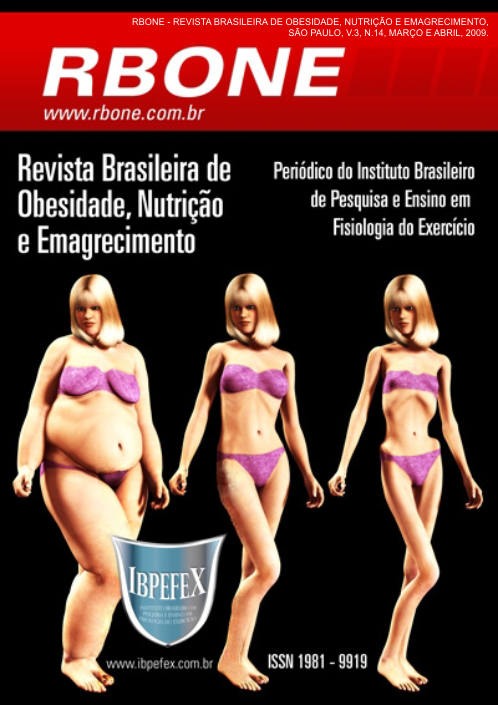Profile anthropometric of participant adolescents of a project of school of volleyball of Curitiba
Abstract
The volleyball is classified as a collective sport game that constitutes modalities that are characterized by complex opposition relationships and of cooperation that you/they elapse of the players' objectives and of the teams in confrontation and of the knowledge that these possess of the game of itself own and of the opponent. Their particularities live fundamentally in his/her structural form and in their resulting characteristics of the technical regulation. The objective of this study was to describe the female profile of adolescents and masculine participants of the volleyball school Programs Esporte Cidadão Unilever. They participated in the study a total of 75 adolescents, being 52 girls and 23 born boys in 1995. The collection of the data was accomplished by five teachers of the program, each one in his/her specificity of evaluations anthropometrics and own equipment was used for this procedure. The results were submitted to the statistical analysis. He/she was discovered that the fold cutaneous triciptal was the only variable that presented significant difference in the data collected anthropometrics and that some were varied correlate positively. The evaluation anthropometric is important to show us the Real data of the students' health, could guide them like this, for activities regular, good physical feeding and social coexistence so that diseases related a corporal fat are avoided.
References
- Afonso, C. A. O conhecimento do treinador a respeito das metodologias de ensino e do treino de voleibol na formação. Tese de Doutorado. Faculdades de Ciências do Desporto e de Educação Física, Universidade do Porto. PORTUGAL, 2001.
- Dutra, L.N.; e colaboradores. Perfil antropométrico da seleção brasileira juvenil de voleibol de 2003. Boletim da Federação Internacional de Educação Física. Vol. 74. 2004. p. 162-165.
- Graça, A.; Oliveira, J. (Org). O ensino dos JDCs. FCDEF – Universidade do Porto. PORTUGAL, 1998.
- Ferreira, J.S.; Neves, C. Avaliação antropométrica de meninos praticantes de escolinhas de futebol. Revista Digital - Buenos Aires – Año. 12. Num. 118 - Marzo de 2008.
- Filardo, R.D.; Rodrigues-Añes, C.R.; Pires Neto, C.S. Antropometria e composição corporal de jovens do sexo feminino entre 13 e 17 anos de idade. Revista Brasileira de Cineantropometria & Desempenho Humano. Vol. 2. Num. 1. 2000. p. 66-71.
- Massa, M.; e colaboradores. Análise de referencias cineantropométricos de atletas de voleibol masculino envolvidos em processos de promoção de talentos. Rev. Mack. Educ. Fis e Esp. Vol. 2. Num. 2. 2003. p. 101-113.
- Nascimento, K.; e colaboradores. Do lúdico à especialização: análise da importância de um programa de estimulação motora como meio de desenvolvimento da valência física velocidade no voleibol. Artigo. Revista Digital EF Deportes. Buenos Aires. Ano. 9. Num. 56. Jan 2003.
- Paula, A.H. Análise antropométrica em escolares entre 11 e 14 anos de idade da cidade de Caratinga, MG. Revista Digital - Buenos Aires - Año 8. Num. 50 – Julho, 2002.
- Silva, K.K.; Lamp, C.R. Relação do índice de massa corporal, percentual de gordura e sua interpretação. www.revista.ulbrajp.edu.br; 20/03/2009, 16hs42min.
- Silva, M. Classificação Morfológica de Voleibolistas do Sexo Feminino em Escalões de Formação. Revista Brasileira de Cineantropometria & Desempenho Humano. Vol. 5. Num. 2. 2003. p. 61-68.
- Silva, E.L.; Menezes, E.M. Metodologia da pesquisa e elaboração de dissertação. 3ª Ed. Florianópolis: Laboratório de Ensino à Distância da UFSC, 2001.
- www.cbv.com.br; agosto, 2005; 22hs09min.
Authors who publish in this journal agree to the following terms:
- Authors retain the copyright and grant the journal the right of first publication, with work simultaneously licensed under the Creative Commons Attribution License BY-NC which allows the sharing of the work with acknowledgment of the authorship of the work and initial publication in this journal.
- Authors are authorized to enter into additional contracts separately for non-exclusive distribution of the version of the work published in this journal (eg, publishing in institutional repository or book chapter), with acknowledgment of authorship and initial publication in this journal.
- Authors are allowed and encouraged to post and distribute their work online (eg, in institutional repositories or on their personal page) at any point before or during the editorial process, as this can bring about productive change as well as increase impact and impact. citation of published work (See The Effect of Free Access).






